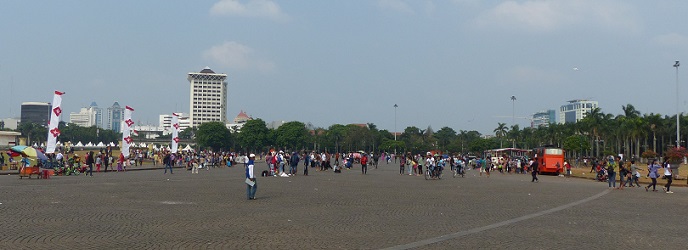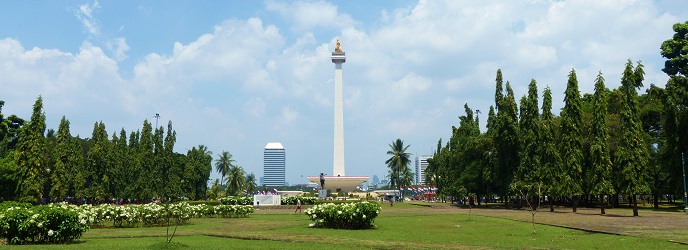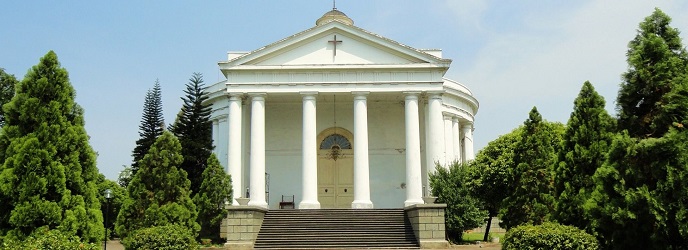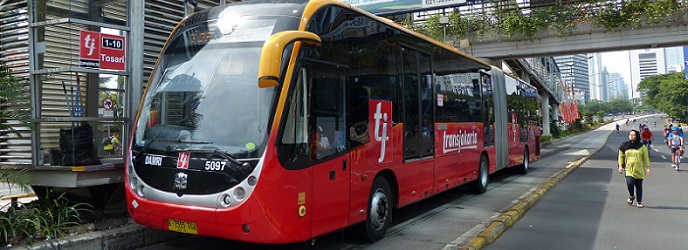Jakarta Travel Guide
Jakarta is the capital city of Indonesia, located in the northwest on the island of Java. With a population exceeding 10 million people it is the biggest Indonesian city. Although this metropolitan city forms the political and economic center of Indonesia, there is still plenty of cultural and historic richness to be found ranging from the old colonial city center (known as Old Batavia or Kota Tua), museums, antique markets to art and world-class music festivals or exhibitions. However, be ready to get stuck in traffic, inhale pollution, get fooled by taxi drivers, and become the center of attention on the streets of Jakarta.
Jakarta, the Big Durian
The durian fruit, native to Southeast Asia, is remarkable. It is regarded the "king of fruits" due to its distinctive (large) shape and rich flavour (although for some the taste is too awkward). Durian is also known as being the smelliest fruit in the world due to its distinctive (read: awful) smell (although for some it is actually a pleasant smell). Here we can find an analogy that is often used. Jakarta is often called the "Big Durian". This nickname is fitting because Jakarta is not only an enormous city but also a smelly one due to pollution (caused by people's lack of environmental awareness, the huge number of people living in limited space, and badly maintained sewerage systems). But this is only half of the analogy. Most people describe the taste of durian as heavenly. Although it is highly inappropriate to label Jakarta as 'heaven-like', it is true that - after living in Jakarta for some time - many people start to appreciate Jakarta, and become proud being a Jakartan. Many of those who migrated from the villages to Jakarta in search of a job or university degree will only go back to the villages for a short holiday, not permanently. This is not simply a matter of salary alone; they have become used to the busy 24/7 city life, big malls, crowds of people, and restaurants and cafes on every street. Village life, on the other hand, has become boring and is characterized by a lack of modernity. Never a dull day in Jakarta though.
Jakarta is a big city but those who stay here for at least one week will have enough time to visit the most important tourist attractions that the city offers. But where to start the sightseeing tour when we visit Jakarta?
Merdeka Square (Medan Merdeka)
Well, we are going to start right in the heart of Jakarta. Here - in Central Jakarta - we find a big square called the Merdeka Square (merdeka means independence in Indonesian). The size of this square is remarkable (estimated at 75 hectares) causing some to claim that Merdeka Square is the largest square in the world. This is indeed a breather: as Jakarta, particularly in the center, is characterized by dense and vertical infrastructure and property development (due to the limited availability of land), it feels great to stroll along this spacious square, while skyscrapers become our horizon. But you will not be alone. Thousands and thousands of people - mostly Indonesians - visit this square, particularly in the weekends or on public holidays, to walk around (some jogging), play a game of soccer, have a picnic or just relax and take pictures (selfie!).
Yes, (young) Indonesians love their camera application on mobile devices and seem to make any excuse to take pictures and selfies (particularly "group-selfies"). At tourist locations, such as Merdeka Square, it frequently happens that they will invite a foreigner to take a picture with them. This has become some sort of tradition. For a foreigner this is the opportunity to feel like a movie star!

A handy tip when visiting Merdeka Square is to bring an umbrella. Jakarta, with its tropical monsoon climate, has a wet season that runs from October to May (usually peaking in January). However, the umbrella will not only protect you from rainfall but will also protect you from the bright sunshine at daytime. A sunburn is easily caught when enjoying Merdeka Square between 10:00 am and 15:00 pm on a sunny day.
At Merdeka Square you can stroll, relax, sit in the grass and enjoy cheap traditional food dishes (for example bakso, nasi uduk or ketoprak) sold by the local street food vendors. You can also search for souvenirs, such as t-shirts, small wooden statues, ash trays, bracelets and much more, sold by the local street vendors (prepare to bargain!). However, right in the center of Merdeka Square there is one tall tower that catches our attention. It is an icon, or landmark, of Jakarta.
National Monument (Monumen Nasional, Monas)
Right in the center of Merdeka Square you will see Indonesia's National Monument (Monumen Nasional, abbreviated Monas), a 132 meter-tall tower that was built to commemorate Indonesia's struggle for Independence. It was the late and great Sukarno (the first president of Indonesia) who pushed for construction of this tower, inspired by the Eiffel Tower in Paris (France). Construction began in 1961 and Monas was finally opened to the public in 1975 (five years after Soekarno's death).
The design of Monas is fairly simple but full of traditional symbolism. Sukarno, himself an architect, did not design the monument (these credits go to Frederich Silaban and R.M. Soedarsono) but played a crucial role by forcing the form of a lingga and yoni, important concepts from Hindu traditions (traditional Javanese and Balinese cultures are highly influenced by Hinduism). These concepts symbolize harmony, fertility and eternal life: the lingga phallic symbol represents masculinity, positive elements, and daytime, while the yoni symbolizes the female organs, representing femininity, negative elements, and night. For Sukarno such concepts were familiar growing up in a traditional Javanese family in East Java (with Balinese influences from his mother's side of the family).

At Monas you can do two things: firstly, you can go to the (near) top with the elevator to enjoy a great view of Jakarta. Tickets are cheap but the biggest challenge is the long queue. Therefore it is advised to come early (before 10:00 am) to avoid an hours-long wait. This viewing platform (or observation deck) is about 115 meters above ground level, just below the bronze flame which - reportedly - is covered by a layer of gold foil.
Secondly, you can visit the National History Museum and Hall of Independence located in the base of Monas. Here you can view dioramas displaying prehistoric times and Indonesia's political history (from the precolonial times of Srivijaya and Majapahit to the struggle for Independence from the Dutch colonial power, up to Suharto's New Order regime). The original text of Sukarno's Proclamation of Independence - announced on 17 August 1945 in Jakarta - is stored in the Hall of Independence.
Sightseeing in Central Jakarta
We have enjoyed Merdeka Square and Monas but we want to delve more into the history of Jakarta, especially the colonial history. Where are the remnants of this colonial period? We have heard stories about Old Batavia (Kota Tua) - the old administrative center of the Dutch - where plenty of traditional Dutch architecture can be found. This area is located in the north of Jakarta, close to the sea. But before we go there, let us realize the rich historic heritage around Merdeka Square, only a stone's throw away from us!
The Merdeka Square (previously called Koningsplein or King's Square in colonial days) and its surrounding area actually became the administrative center of the Dutch starting from the late 18th century (after authorities moved this center away from the north i.e. Old Batavia due to malaria epidemics in the north). Therefore there are various places of historic interest to visit in this area.
Merdeka Palace (Istana Merdeka)
The first place to visit (although we cannot enter as it is still being used as one of Indonesia's six presidential palaces) is Merdeka Palace (Istana Merdeka), located on the north side of Merdeka Square. This palace was built by the Dutch in the second half of the 19th century and has remained largely unchanged. Although the Merdeka Palace does not have an administrative role anymore, it still serves as a venue for official state events (including the welcoming of foreign statesmen, Independence Day ceremonies, cabinet meetings, and such). This palace is open to the public a few days per year.
Istiqlal Mosque, Immanuel Church & Jakarta Cathedral
Also, still in walking distance from Merdeka Square, there are three famous places of worship. Firstly, the Istiqlal Mosque, built in the 1960s and 1970s and located northeast of the Merdeka Square. Just like the word merdeka (Indonesian), istiqlal (Arabic) means 'independence'. As such it also commemorates Indonesian Independence from the Dutch colonial power. Reportedly, Indonesia's Istiqlal Mosque is the largest mosque in Southeast Asia. For more information about Islam in Indonesia visit our Islam section.
Secondly, the Immanuel Church (Gereja Immanuel), located east of Merdeka Square. This Protestant church may be the oldest existing church in Indonesia. Construction - on the initiative of Dutch Reformed and Lutherans in Batavia - started in 1838 and took five years before being completed. During Dutch rule the church was known as Willemskerk named after king William I of the Netherlands. Up to the present the church conducts a service in the Dutch language (every Sunday at 10:00 am local Jakarta time). Here you can meet a handful of nice elderly Indonesian people who faithfully attend the service. For more information about Christianity in Indonesia, visit this section.

Thirdly, located almost next to the Istiqlal Mosque, you can pay a visit to Jakarta's Roman Catholic Cathedral, seat of the Roman Catholic Archbishop of Jakarta. Originally, this church was built in the first half of the 19th century. However, it collapsed in 1890. The current Cathedral is mainly the result of rebuilding (in neo-gothic style) between 1891 and 1901 with Pastor Antonius Dijkmans as architect. The Cathedral's official name is Gereja Santa Perawan Maria Diangkat Ke Surga (taken from Dutch De Kerk van Onze Lieve Vrouwe ten Hemelopneming which, in English, means "Church of Our Lady of Assumption").
Banteng Square (Lapangan Banteng)
Next to Jakarta's Cathedral we find the Banteng Square (in Indonesian: Lapangan Banteng). Although there is not much to see, except for a landmark statue (that symbolizes the liberation of West Papua from the Dutch), this square was a very important one during the last century of Dutch colonial rule, being the main parade and ceremonial square (the Dutch called it Waterlooplein). In those days there stood a big statue of Jan Pieterszoon Coen, founding father of Batavia, at the northeastern side of the square (which was removed after Independence). Today, several months per year, the square is used for flaura and fauna exhibitions.
National Museum of Indonesia (Museum Nasional)
Lastly, on the west side of Merdeka Square you will find the National Museum of Indonesia (in Indonesian: Museum Nasional). This museum contains a wide variety of cultural items of many ethnic groups as well as many remnants from the Hindu-Buddhist period (such as beautiful stone statues). In front of the museum you will see a bronze elephant statue which was a gift from the king of Thailand in 1871. This museum was opened in 1868!
Transportation in Jakarta
We have now seen quite a lot of key historic sites that Central Jakarta has to offer and now we want to visit the oldest part of Jakarta: Old Batavia (Kota Tua). But how will we go there? This is perhaps the right moment to dedicate some words to the issue of transportation in Jakarta.
Obviously the easiest way to travel for a tourist is to take a taxi. The advantages are that it will usually be easy to find a taxi in Jakarta, it is relatively cheap (compared to taxi rides in other countries), and it is comfortable (you can enjoy the air-conditioning). The disadvantages of a taxi drive are: many taxi drivers will not take the fastest route (in order to let the meter run long) and you can get stuck in traffic (this can be a stressful and time consuming matter, particularly from Monday to Friday).
There are more than a dozen of taxi services companies active in Jakarta. However, most of these will have unreliable drivers. Two companies that are considered reliable are Blue Bird and Taksi Express. Blue Bird are the blue-coloured taxis, but be careful there are also taxis that look very similar to Blue Bird cars but are not part of this company, so always check whether there is the text "Blue Bird" or "Pusaka" on the side or front of the car (both are part of the Blue Bird Group). Taksi Express are white-coloured taxis. Although Blue Bird and Taksi Express are considered the most reliable taxi services providers in Indonesia both companies also have plenty of drivers who will try to make some extra money from tourists, for example by taking the long way or pretending not to have any change. As most drivers cannot speak English, they can take advantage of miss-communication.
If you want to take a more adventurous journey then there are a couple of other choices. For example the three-wheeled orange and noisy bajaj, which are very similar to the ones used in India (auto rickshaw) or the tuk-tuk in Thailand. However, be prepared to bargain before you start the ride on this two-seater. The ride will be bumpy and chaotic (and you will inhale pollution from traffic) but it is a very interesting adventure. Due to the smaller size of the bajaj it can easier go through heavy traffic (compared to passenger cars or buses).

Another possibility is to take a bus. There are various bus services companies active in Jakarta but the best option is the TransJakarta line, which is owned by the local Jakarta administration (these buses usually have a separate lane in traffic but - despite violating the law - other traffic frequently uses these lanes). TransJakarta buses are comfortable (with air conditioning), relatively clean and - besides the driver - there usually is a staffmember standing in the middle of bus (this somewhat raises the comfort of feeling safe). However, if you take the TransJakarta in the morning when many Jakartans go to their offices or between 4-7pm (when they return home) these buses are packed with people and you may need to wait hours in a chaotic line at the bus stop before you can enter the bus. At these moments the TransJakarta is highly uncomfortable (and it increases chances for pickpockets).
We decide to take the TransJakarta to Old Batavia. West of Merdeka Square, near the National Museum, there is a bus-stop. The ride towards the oldest part of Jakarta located in the north of the city takes only 15 minutes (because there is not much traffic today). During the ride you will pass by Harmoni Square, Majapahit Street (Jalan Majapahit) and Glodok (Chinatown). All these areas actually have a long and interesting history but due to our limited time we cannot visit these places today.
Under Construction
